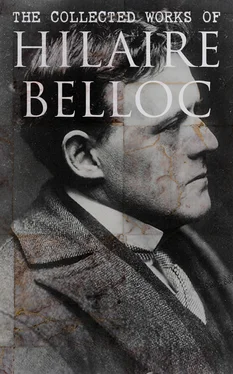IV
THE PRELIMINARIES OF THE BATTLE
Table of Contents
The arrival of Louis Francis, Duke of Boufflers, peer and marshal of France, upon the frontier and before the army of defence, was one of those intangible advantages which the civilian historian will tend to exaggerate and the military to belittle, but which, though not susceptible of calculation or measurement, may always prove of vast consequence to a force, and have sometimes decided between victory and defeat. This advantage did not lie in Boufflers’ singular capacity for command, nor, as will presently be seen, was he entrusted with the supreme direction of the action that was to follow. He was a great general. His service under arms had occupied the whole of his life and energies; he was to have a high and worthy reputation in the particular province of his career. But much more than this, the magic of his name and the just prestige which attached to the integrity and valour of the man went before him with a spiritual influence which every soldier felt, and which reanimated the whole body of the defence. His record was peculiarly suited for the confirmation of men who were fighting against odds, under disappointment, at the end of a long series of defeats, and on a last line to which the national arms had been thrust back after five years of almost uninterrupted failure.
Boufflers at this moment was in his 66th year, and seemed older. His masterful, prominent face, large, direct, humorous in expression, full of command, was an index of a life well lived in the business of organisation, of obedience, and at last of supreme direction. Years ago at Namur his tenacity, under the pressure of a superior offensive, had earned him the particular character which he now bore. Only the year before, his conduct of the siege of Lille, when he had determinedly held out against the certitude of ultimate surrender, had refused to yield the place even after receiving orders from his sovereign, and had finally obtained, by his unshakable determination, a capitulation of the most honourable kind, was fresh in the minds of all. There is a story that on his arrival in the French camp the cheers with which he was greeted reached the opposing line, and that the allies were moved by the enormous rumour to expect an instant assault. He was one of those leaders who, partly through their legend, more through their real virtue, are a sort of flag and symbol to the soldiery who have the good fortune to receive their command.
Nine years the senior in age of Villars, of a military experience far superior, in rank again possessed of the right to supreme command (for he had received the grade of marshal long before), he none the less determined to put himself wholly at Villars’ orders, for he knew of what importance was continuity of direction in the face of the enemy. At the end of the last campaign, when he had expected peace, he had honourably retired. His life was nearing its close; in two years he was to die. He sacrificed both the pretension and the fact of superiority so dear to the commander, and told Villars that he came simply as a volunteer to aid as best he might, and to support the supreme command in the coming fight.
He had arrived at Arras on the same day that Tournai had surrendered. Upon the morrow he had reached Villars’ headquarters near Douai, Sin le Noble, in the centre of the defensive line. He had followed the easterly movement of the mass of the French army along that line to their present establishment between the two woods and to the terrain whereupon the action would be decided. In that action he was set at the head of the troops on the right, while Villars, attending in particular to the left, retained the general command and ordered all the disposition of the French force.
* * * * *
The landscape which lay before the French commanders when upon the Monday morning their line was drawn up and immediate battle expected, has changed hardly at all in the two hundred years between their day and ours. I will describe it.
From the valley of the Sambre (which great river lies a day’s march to the south of the French position) the land rises gradually upward in long rolls of bare fields. At the head of this slope is a typical watershed country, a country that is typical of watersheds in land neither hilly nor mountainous; small, sluggish streams, lessening to mere trickles of water as you rise, cut the clay; and the landscape, though at the watershed itself one is standing at a height of 500 feet above the sea, has the appearance of a plain. It is indeed difficult, without the aid of a map, to decide when one has passed from the one to the other side of the water parting, and the actual summit is, at this season of the year, a confused, flat stretch of open stubble fallow, and here and there coarse, heathy, untilled land. For two or three miles every way this level stretches, hummocked by slight rolls between stream and stream, and upon the actual watershed marked by one or two stagnant ponds. Seven miles behind you as you stand upon the battlefield lies the little French market town of Bavai, which was for centuries one of the great centres of Roman rule. It was the capital of the Nervii. Seven great Roman roads still strike out from it, to Rheims, to Cologne, to Utrecht, to Amiens, to the sea. Two in particular, that to Treves and that to Cologne, spreading gradually apart like the two neighbouring fingers of a hand, are the natural ways by which an army advancing to such a field or retreating from it would communicate with Bavai as a base. 8
The outstanding feature of this terrain is not that it is the summit of a watershed; indeed, as I have said, but for a map one would not guess that it bore this character, and to the eye it presents the appearance of a plain; it is rather the symmetrical arrangement of it as a broad belt of open land, flanked upon either side north and south by two great woods. That upon the right is known as the wood of Lanière, that upon the left bears several names in its various parts, and is easiest to remember under the general title of “The Forest of Sars.” The gap between these two woods narrows to a line which is precisely 2000 yards in extent and runs from north-west to south-east, the two nearest points where either wood approaches the other being distant one from another by that distance and bearing one to the other upon those points of the compass. The French army, therefore, drawn up on the open land and stretching from wood to wood, faced somewhat north of east. The allies, drawn up a mile and a half away on the broad beginning of that gap, looked somewhat south of west. Behind the latter at a day’s march was Mons; behind the former some seven miles was Bavai; and the modern frontier as well as the natural topographical frontier of the watershed runs just in front of what was then the emplacement of the French line.
Upon the French side the bare fields are marked by no more than a few hamlets, the chief of which is the little village of Malplaquet, a few houses built along what is now the main road to Brussels. Certain of the French reserve were posted in this village, accompanied by a few sections of artillery, but the fields before it lay completely open to the action.
Upon the Belgian side a string of considerable villages stretched; three of them from right to left marked the principal position of the allies. Their names from north to south, that is, from the left of the allies to the right, are Aulnois, Blaregnies, and Sars. The first of these lies right under the wood of Lanière; the second faces the gap between the woods; the third lies behind the left-hand wood, and takes its name from it, and is, as we have seen, called the forest of Sars. 9
The dispositions which the French army would take in such a defensive position were evident enough. It must defend the gap by entrenchment; it must put considerable forces into the woods upon the right and to the left of the gap to prevent the entrenchments being turned. The character of Villars and the French tradition of depending upon earth wherever that be possible, was bound, if time were accorded, to make the entrenchment of the open gap formidable. The large numbers engaged upon either side left a considerable number at the disposal of either commander, to be used by the one in holding the woods, by the other in attempting to force them; not much more than half of the French force need stand to the defence of the open gap. This gap was so suitable, with its bare fields after harvest, the absence of hedges, the insignificance of the rivulets, for the action of cavalry, that gates or gaps would be left in the French entrenchment for the use of that arm in order to allow the mounted men to pass through and charge as the necessity for such action might arise. In general, therefore, we must conceive of the French position as strong entrenchments thrown across the gap and lined with infantry, the cavalry drawn up behind to pass through the infantry when occasion might demand, through the line of entrenchment, and so to charge; the two woods upon either side thickly filled with men, and the position taken up by these defended by felled tree trunks and such earthwork as could be thrown up with difficulty in the dense undergrowth.
Читать дальше












